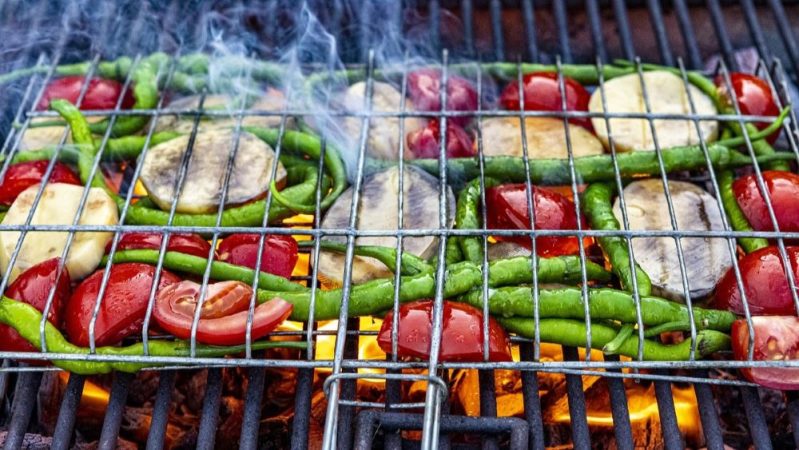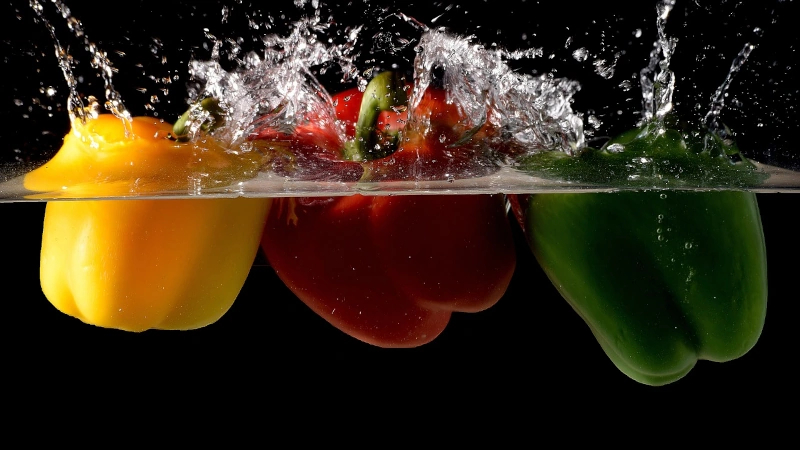First of all, why grill? From a health standpoint, grilling is a great way to prepare plants without having to add extra fat in preparation. When it comes to flavor, grilling takes the depth and complexity of veggies up a notch; plus, it brings out the natural sweetness in fruits. This summer, go beyond just firing up the barbeque for meat, and, instead, make your cookout tasty and plant-powered!
There are lots of plants that lend themselves to grilling. Let’s start with veggies. Choose from classics like grilled peppers, onions, and summer squash to more non-traditional, trendy options like cabbage or cauliflower steaks, asparagus, and sliced Brussels sprouts. Hearty produce like savory portabella mushrooms, corn on the cob, carrots, and potatoes are also great choices. You really can’t go wrong!
A good hack to add even more flavor is to marinate your vegetables as you might typically do with an animal protein prior to grilling. A good marinade just has a few raw ingredients including oil, such as canola or olive oil, something acidic like citrus fruits or vinegar, and your favorite herbs and spices. Marinate your veggies for at least 30 minutes before throwing them on the grill.
When it comes to grilling vegetables, timing is key. Some vegetables like carrots and potatoes will need to cook for a little longer than say asparagus or squash. If you are grilling a bunch of veggies together, place your hearty vegetables on the grill first, cook for 3-4 minutes or until they are about a quarter- to halfway through cooking, then add the rest of your vegetables. Most of the time, 8-10 minutes, with one flip, will be enough time to get in that sweet spot: when your veggies are cooked through and tender, but are still a little crisp or have a slight “bite” to them.
For a plant-packed side dish or snack, grill up an assortment of vegetables and serve warm with a homemade dressing or dip made from Greek yogurt, lemon juice, garlic, and fresh herbs.

We can’t forget fruit! Grilling fruits like watermelon, pineapple, and peaches, caramelizes the sugars and intensifies the flavor. Plus, it’s easy to do! Take watermelon, for instance. Simply slice your watermelon into wedges leaving the rind attached. This will keep the watermelon flesh from falling apart when you flip it with tongs during cooking. Hint: a mini watermelon that is less than 5 pounds, maybe the perfect size for about five to six people. For a sweet and spicy alternative, after slicing, sprinkle a rub on your watermelon wedges. Use white or brown sugar, flavored with a little salt, lime, and other spices like cumin or red pepper flakes. Grill the watermelon on high heat for about 2 to 3 minutes per side. Serve as is or cut the flesh off the rind and toss with leafy greens, feta cheese, balsamic vinegar, and fresh mint. For a doubly refreshing dessert on a hot day, serve grilled watermelon with a scoop of frozen yogurt or ice cream!
‘Tis the season for chillin’ and grillin’, and a plant-powered cookout is sure to keep those summer vibes flowin’ all season long!
Try This Recipe!
Vegan Street Corn

Ingredients
- 2 ears of corn
- 2 tbsp olive oil
- ¼ cup vegan mayo
- 2 tsp nutritional yeast
- ¼ tsp black pepper
- ¼ tsp cumin
- ½ tsp paprika
- ¼ tsp salt
- 2 tsp fresh lime juice
- 2 tbsp minced cilantro
- 2 tbsp sliced green onion
Instructions
1. Shuck corn and either grill or cook on the stove with olive oil. Rotate corn so every side turns golden yellow and caramelizes to your taste.
2. While the corn cooks, whisk together mayo, nutritional yeast, pepper, cumin, paprika, salt and lime juice.
3. Slice green onion and mince cilantro.
4. When the corn is done, drizzle on your seasoned mayo and top with cilantro and green onion before serving.
The post Chillin & Grillin first appeared in The Foundation for Fresh Produce’s Have A Plant® blog.
Written by: Elizabeth Hall, PhD, RDN, LDN, Program Director & Assistant Professor at Harding University
Dr. Elizabeth Hall has practiced as a Registered Dietitian Nutritionist in clinical, foodservice, behavioral health, and business/retail. Elizabeth currently serves as an assistant professor in Harding University’s Applied Dietetics Practice program and as a health and well-being resource providing nutrition messaging, educational content, and media interviews for retail and food industry nonprofit organizations. Her research focuses on public health interventions to improve food environments.
About The Foundation For Fresh Produce And Have A Plant® Movement


The Foundation for Fresh Produce’s vision is to grow a healthier world by changing the trajectory of human health. The produce industry has the potential to provide solutions for many of the world’s greatest health and economic challenges – especially those surrounding nutrition and hunger.
The Foundation focuses on improving the appeal of fruit and vegetables as an integral part of people’s diets, supporting the development of infrastructure and supply chain solutions that provide easier access, and establishing strategic alliances that enable children and families to form healthier eating habits.
The transformative Have A Plant® Movement inspires consumers with compelling reasons to believe in the powerful role fruits and vegetables can play to fuel happy, healthy and active lifestyles.



